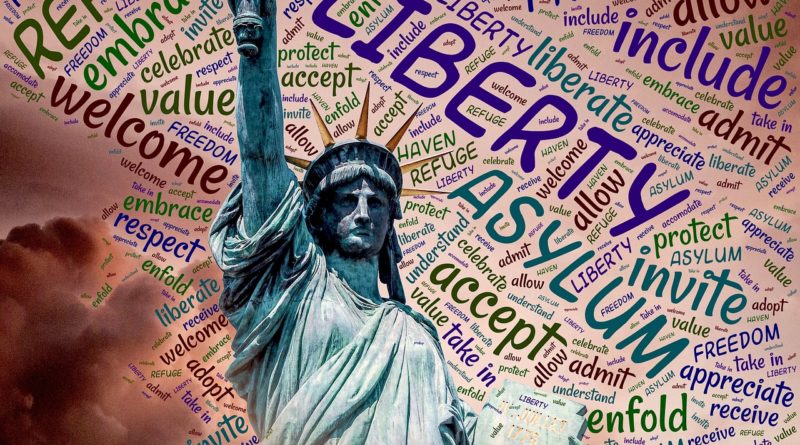Immigrating Care Ethics into the Immigration Crisis
Immigrating Care Ethics into the Immigration Crisis
Mean 78.1, High 95, This paper’s score: 95
As an immigrant and refugee to this country, immigration is a big deal to me. As such for my final paper for my Philosophy Ethics class at Penn State University this semester, I wrote on the idea of introducing care ethics to immigration judgement and enforcement, from the bench and in the field.
“Care becomes the mercy that tempers justice” (Kittay, Meyers, 1984, 24). ”
The Full Paper
Ronald Hall
Prof. Ayesha Abdullah
Philosophy 103W
23 April 2017
Immigrating Care Ethics into the Immigration Crisis
Immigration policy in the United States is largely enforced by a rule driven or ‘justice based’ system. Increasingly as an illegal immigrant is found, they are detained and deported simply for crossing the border illegally. There are illegal immigrants who cross the border and commit crimes once they are here. These immigrants are most likely served justly by ‘justice based’ decisions of deportation. There are however other cases where deportation is the result of a justice based decision based on no other transgression than crossing the border illegally. In these cases, a ‘care based’ decision may yield a better outcome both for the immigrant and for society-at-large and could potentially lead to an evolution on societal views towards illegal immigration. Care based ethics if implemented into the United States immigration deportation policy could not only reform the immigration system but could change society as a whole if the care perspective were viewed equal to the justice perspective by decisionmakers and authorities.
Many illegal immigrants come to the United States each year. Guadalupe Garcia de Rayos came to the United States in 1990’s as a 14-year-old with her parents. She sought a better life for herself and later her children. She no violent criminal past or violent criminal record. She reported to yearly immigration check-ins. After the 2016 Presidential election, fear spread through the immigrant community and Guadalupe Garcia de Rayos found herself deported after a routine check-in with ICE. It is believed she may have been the first deportation from Arizona under the new presidential administration. The harm done to the children emotionally by this decision was evident by a statement by her daughter Stephanie: “We don’t deserve to go through this. No family deserves to go through this. It’s heartbreaking. No one should feel this much pain, no one should go through this much suffering,” as reported by CNN. Her children are the ones who suffer through the process.
Her children were born in the United States but cross the border to be with their mother. According to activist Lucy Sandoval, “She wanted to confront this,” Sandoval said. “They were hopeful that there would be some consciousness and some heart.” But instead de Rayos faced a chilling terror that may be shared by many to come, a cold execution of justice, for in the estimation of ICE, she committed a crime, went through the justice system, and was deported. Both of these outcomes – the heart Sandoval cited and the actual outcome of deportation that occurred – have been studied within an established framework by psychologist and ethicist Carol Gilligan
Psychologist and ethicist Carol Gilligan presented two ethical perspectives that may be best described as two parts of a whole perspective, justice based and care based ethical decision making. The justice perspective is based largely on transgression of existing rules and the rights of those transgressed upon while the care based perspective is largely based on decision-making that considers the context of the situation, the whole person, and the value of relationships.
The justice based perspective of Carol Gilligan’s theory is based largely on rules. The justice based perspective implies a trespassed has occurred and that another’s rights have been violated. An article on ethics from the University of South Carolina summarized, “According to Gilligan, some people base ethical decisions on principles of justice, equality, impartiality, and rights. This is the justice perspective.” (Andre, Velasquez 2017). It is important to re-state the basis of the justice based decision making for the example of the moles and the porcupine.
“A porcupine [nungu] was seeking refuge from the cold and asked to share a cave with the mole [mphuko] family. The moles agreed but the cave was too small, such that each time porcupine moved, its spikes scratched the moles. Moles complained bitterly and asked porcupine to leave their cave. But the porcupine refused and instead asked the moles to leave if they felt uncomfortable.” (Mwale, M. 1970.)
In Gilligan’s estimation, the justice perspective would have the mole evict the porcupine based on justice alone – it’s the mole’s home not the porcupine. The justice based perspective seeks to have the porcupine leave. It’s the mole’s house so the porcupine must go. This example illustrates that justice views it as a conflict (paraphrase, Study.com, 2017). Guadalupe Garcia de Rayos’ situation can have similar justice applied to it.
The justice perspective would interpret Guadalupe Garcia de Rayos’ presence in the United States as a conflict or transgression. It would examine the rights of those already living here and determine that Guadalupe Garcia de Rayos was the transgressor and ultimately seek a resolution that preserves the existing citizens’ rights and as a result sends Garcia de Rayos back to Mexico. The justice based perspective largely occupies the court system as well as forms the perspective for actions by Immigrations and Customs Enforcement, otherwise known as ICE. Those embracing the justice perspective would largely back deportations like Garcia de Rayos’ without hesitation and justify them with facts and evidence of immigration law. In the end, the justice based decision making preserves the rights of those that live here already. In the United States, the justice perspective has been and continues to be the accepted ‘law of the land’. But there are alternatives.
Carol Gilligan presented the ‘care’ perspective in direct contrast to the ‘justice’ perspective. The care perspective views the issue contextually, allowing one to take into account a person’s background, relationship, and wellbeing. There is a place for justice in our immigration system but I argue that those executing justice should also look at care as a potential perspective in decision-making. They both do exist and could be seen from the bench and in the field. The exist simultaneously.
In Carol Gilligan’s care vs justice framework, she looks at the two different moral directions. Decisions that are based on justice often are based on fairness, rules, impartiality, and prior agreements. Decisions based on care are based on helping those in need, recognizing people are stronger connected than isolated, and acting as an agent of concern. Care and Justice are hard to see at the same time as the selection “Moral Orientation and Moral Development” describes. Eva Feder Kittay and Diana T Myers write how it’s like looking at an ‘gestalt psychology image’ such as ‘a drawing that may be seen as a duck or as a rabbit…’ and goes on to state ‘The care and the justice perspectives, claims Gilligan, cannot simply be integrated, nor are they polar opposites…’ and concludes the summary by saying ‘but as in the case of the ambiguous figure, we can see the same situation only from one perspective at one time’. (Kittay, Meyers, 1984, p19) The challenge becomes shifting our views so we can see both and perhaps “Care becomes the mercy that tempers justice” (Kittay, Meyers, 1984, 24). Kittay and Meyers both do an adequate job of explaining Gilligan’s overview but there is an aspect of the theory that Gilligan herself addresses rather effectively.
Gilligan herself talks about the aspect of care ethics that center on relationship. “The ethics of care starts from the premise that as humans we are inherently relational, responsive beings and the human condition is one of connectedness or interdependence.” (Gilligan, 2015). What Gilligan points to here is the real-world nature of our interconnectedness vs. theories that often don’t match what is encountered in real life. Gilligan continued to state, “I was impelled to write about an ethics of care by the disparities I heard between the voice of moral theories and the voices of people on the ground.” (Gilligan, 2015). The ethics of care as they pertain to relationships reflect real life situations. It’s not a matter of deduction or mathematics but a matter of how we respond, how we listen, and how we act. Ethics of care speak to our need to survive as people – with people. Referring back to the situation with the mole and the porcupine, a care based perspective would seek a solution that would serve both the moles and the porcupines such as putting a blanket around the porcupine so the moles would not get hurt by the spines, or another such compromise that would allow both to stay. Guadalupe Garcia de Rayos’ situation might have looked very different as well with the care perspective engaged.
Guadalupe Garcia de Rayos’ best chance to stay in the US would have been under the ‘care based’ perspective. The care based perspective reflects what advocate Lucy Sandoval expressed in the CNN reporting previously cited, “some heart”. By making decisions based on “some heart”, or as Gilligan would say, a “care” perspective, not only would be people’s lives be changed as immigrants perhaps society in the United States could evolve to a new stage of development. A care based perspective would take into account the context of her situation, which in this case may be her children. The harm done to her children emotionally, developmentally, and socially would be taken into account from a holistic perspective. A care based solution would be to allow de Rayos’ to stay here with her children and seek citizenship since they are American citizens having been born in Arizona. The care based perspective looks at her overall situation and takes a steps back to say ‘what is best relationally? What is the context of this issue? What is best for the person and their support system? Guadalupe de Rayos’ is not the only case that this applies to.
There are other ethical situations in which care vs. justice are at odds. In the medical community hospitals are faced with care for illegal immigrants. In one such situation, another ethical theory is recognized, virtual ethics, which places character as important above rules, or in this case, justice. These decisions are made when patients are admitted and required to be sent back to their home countries, sometimes without proper treatment. One such example was cited in the article, “Immigration, Charity Care and Ethics: What Should Catholic Hospitals Do?” in which Thomas Nairn shares this story:
“Another article shared the story of a 19-year old legal immigrant and an Arizona hospital that disregarded the strenuous objections of his grief-stricken parents’ and sent the comatose young man back to Mexico. Days later, the young man, still in a coma, was transported over the border via a donated ambulance to a California hospital. The Arizona hospital criticized in the article is a Catholic facility,” (Nairn, 2009).
This story, while not a strict story of deportation, illustrates further the dilemma between care and justice and how it goes beyond just immigration checks and human rights. Hospitals do have responsibilities and Nairn brings up the beliefs of Mark Meaney, Ph.D, who is a healthcare ethicist. Meaney cites Thomas Aquinas Summa Theologiae in terms of the actual priority of charity within a hospital’s operation and among those directives, offer charity care but not place it above the common good while still being obligated to give care to those who would not otherwise be cared for if not for the hospital (paraphrase, Nairn, 2009).
I have brought this extra story into this discussion to illustrate the vast possibilities of societal change if ‘care based’ ethical decision making was brought into the US immigration system. Currently in the justice based system it’s an execution of rules and penalties for transgressions of those rules. The author Nairn takes a look at the theories of Kohlberg and Kant in relation to ethical decision-making. Lawrence Kohlberg, an American psychologist, developed a theory of stages of moral development. In his 6th stage, “universal ethical principles”, he speaks of a point where morality isn’t governed by laws but instead by our determination of proper behavior may be. Philosopher Immanuel Kant spoke of a ‘categorical imperative’ in which right and wrong applied equally to everyone, but if one adds the situation to the equation, one could balance justice based ethics with care based ethics when making a decision on immigration from the bench or in the field. By adding a look at the context of the situation, what is wrong in one situation, i.e. crossing the border illegally, using a false social security number, or other transgression commonly cited in immigration could be considered justifiable in seeking medical care, employment, or a better life for future generations of one’s family. Whoever makes the decision could allow the idea that life is to be valued to overtake the law’s execution of justice.
I believe strongly that if care based ethics were adopted into the immigration system, it would could take society to the next evolution of development. Much of society looks to leadership in terms of moral behavior. If immigration policy itself changed from justice to a care perspective, I believe that society would embrace illegal immigrants, have compassion, share resources, and be unafraid. Much of the stigma towards illegal immigrants comes out of fear. A change in ethical approaches could change the entire society’s view of illegal immigration and bring about a new era of understanding, care, and change. Generations of immigrants would be healthier, entire bloodlines would be changed, and the United States as a whole could enter a new era that goes beyond ‘tolerance’ and ascends to ‘embracement’ of the immigrant. Society could learn to overlook it’s fear and embrace the immigrant, leading to a new age of compassion and understanding. This may seem like a pipe dream but there is a basis I have researched to back up this theory of a changed society brought upon by care based decision making,
People tend to follow the leader, and if I theorize correctly, if leadership adopted care-based ethics in immigration policy and execution, society would follow. Michael Maccoby discusses this possibility on a microlevel in a Harvard Business Review article, “Why People Follow the Leader: The Power of Transference”. In it he cites that leaders inspire followers places they haven’t gone and towards change. People follow leaders based on charisma and a sense of caring in their attitude as well as “powerful images and emotions in our unconscious that we project onto our relationships with leaders” (Maccoby, 2004.). He further discusses psychoanalyst Sigmeund Freud’s insight on the idea of transference, how people transfer emotions and experiences from their past relationships onto a present relationship. Maccooby theorizes that the same pheneomon happens in leadership in the workplace and accounts people’s desire to please their leaders. The example given is about a female employee who is very productive and the motivator is that she believes her supervisor will care for her as a parent if she is productive. I believe strongly that society follows it’s leaders in many ways, and this may be one example of how people change based on the leadership they’re under. If the leaders of the United States change their immigration policy from one of justice to one of caring, I believe the same phenomenon would occur and society itself would attain a new level of development and perhaps care ethics would transfer not just from immigration policy but to other policy across the justice continuum.
Immigration policy has been at odds in this country for many decades. Ronald Regan’s amnesty in 1986 opened up the possibility of changes in immigration policy. US society’s views on immigration have changed in the last 30 years. Changing the policy could change society and perhaps evolve it to another level. If US immigration policy decisions came from a care based perspective, the entire society in the United States could progress to another level. Guadalupe Garcia de Rayos does not live in that evolved society just yet.
Guadalupe Garcia de Rayos is now in Mexico and irreparable harm has been to her children as American citizens now having accompanied mother to Mexico. A care based decision may have allowed her to stay and may have opened the door for many other immigrants to stay, spurring on a potential societal change. Immigration law from the justice perspective brings great pain to many in society. “Care becomes the mercy that tempers justice” (Kittay, Meyers, 1984, 24). If care could become the mercy that tempered the justice in our immigration system, perhaps the future becomes a brighter one for American society.
Works Cited
Nairn, Thomas,O.F.M., PhD. (2009). Immigration, charity care and ethics: What should catholic
hospitals do? Health Progress, 90(2), 6-8. Retrieved from http://ezaccess.libraries.psu.edu/login?url=http://search.proquest.com.ezaccess.libraries.psu.edu/docview/274639890?accountid=13158
Grinberg, E. (2017, February 10). Deported mother: ‘I did it for love’ Retrieved April 21, 2017, from http://www.cnn.com/2017/02/09/us/arizona-guadalupe-garcia-de-rayos-protests/
Maccoby, M. (2014, July 31). Why People Follow the Leader: The Power of Transference. Retrieved April 23, 2017, from https://hbr.org/2004/09/why-people-follow-the-leader-the-power-of-transference
Psychological Perspectives on Human Development. (c) 2004, 2008 J. S. Fleming, PhD.pp7-2-7-25
Kittay, Eva Feder and Diana T. Meyers. Moral Orientation and Moral Development. Women and Moral Theory. Totowa. Rowan & Littlefield. 1987. 0847673812. Ch. 1. pp. 19-33.
“Gilligan on Care vs. Justice.” Gilligan on Care vs. Justice. N.p., n.d. Web. 21 Mar. 2017.
Webteam. “Carol Gilligan.” Ethics of care. N.p., 28 Nov. 2015. Web. 21 Mar. 2017.
Internet Encyclopedia of Philosophy. N.p., n.d. Web. 21 Mar. 2017.
Tong, Rosemarie, and Nancy Williams. “Feminist Ethics.” Stanford Encyclopedia of Philosophy. Stanford University, 12 May 1998. Web. 12 Mar. 2017.
“Carol Gilligan’s Theory of Moral Development – Video & Lesson Transcript.” Study.com. N.p., n.d. Web. 21 Mar. 2017.
Andre, Clair and Manuel Velasquez. University, S. C. (n.d.). Men & Women; Justice & Compassion. Retrieved April 03, 2017, from https://www.scu.edu/ethics/ethics-resources/ethical-decision-making/men–women-justice–compassion/ (This article was originally published in Issues in Ethics – V. 3, N. 1 Winter 1990)
Mwale, M. (1970, January 01). MORAL REASONING IN ADOLESCENTS. Retrieved April 03, 2017, from http://maestroarticles.blogspot.com/2010/11/moral-reasoning-in-adolescens.html





